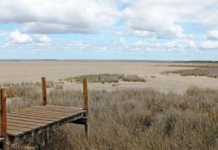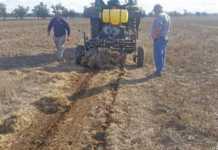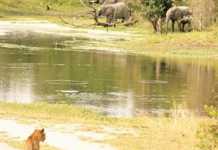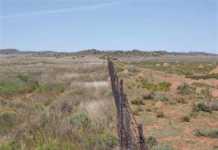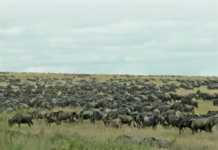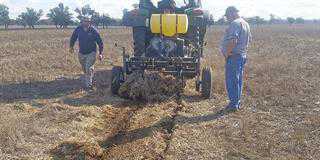Medicinal plants have long formed part of the traditional healer’s arsenal, and the bark of the pepperbark tree (Warburgia salutaris) is popularly used to treat many health problems. Strong demand has placed so much pressure on wild populations that many have disappeared, and the species is now recognised as endangered by the International Union for Conservation of Nature.
Ethno-botanist, Neil Crouch, says that a third of all medical care in South Africa is provided by the traditional health care sector, and warns that this must be recognised as part of species’ recovery. Warburgia project leader and botanist, Michele Hofmeyr, who manages the indigenous plant nursery in the Kruger National Park (KNP), says that cultural belief in the power of the pepperbark remedies is strong. The pepperbark is believed to bring relief to patients suffering from chest problems, coughs and colds.
According to the South African National Botanical Institute (Sanbi), Warburgia is rare in the wild, occurring in northern and eastern KwaZulu-Natal, northern and eastern Limpopo, the Soutpansberg mountains, and Mpumalanga. The KNP’s pepperbark trees are the Soutpansberg’s last surviving wild population.
“In the past, the nyanga (healer) would cut a piece of the bark from the tree to use for treatment; now the bark goes to Johannesburg markets, so the commercial value has increased. Even the thinnest branches are stripped and the whole tree is debarked. This type of harvesting is unsustainable,” says Michele.
Fuelled by the demands of a growing urban population, Warburgia groves in the KNP are repeatedly raided by illegal harvesters. Faced with the threat of permanent population loss, SANParks set up a project aimed at solving problems for tree populations and local communities. The Warburgia project is officially sponsored by Sappi.
.jpg)
Michele Hofmeyr manages the indigenous nursery in Skukuza camp in the KNP.
“We want to stop people coming into the park to collect material from wild groves,” says Michele, “so we plan to supply as many Warburgias as possible, to as many communities as possible, at every opportunity.” Phalaborwa-based social scientist, Louise Swemmer, who handles the distribution arm of the project, says there are 180 villages on Kruger’s western boundary.
“We’re talking about roughly two million people,” she says. “And where there are people, there are opportunities.” Trees are distributed to community leaders and traditional healers at workshops. “It’s the way to go,” says Michele. “Protected trees are harvested because it’s a quick fix. There are not enough trees in the communal areas yet, but Warburgias are fast growers.”
Horticulture helps conservation
Michele says that she prefers to join forces with other people who can help her. “We work with the Lowveld Botanical National Garden (part of Sanbi) and staff members help us with collections, plant identification and landscape surveys.” Plant identification, she explains, is not easy, especially that of less common and rare species, because expert verification is often necessary.
Horticultural skills and practices are needed to make plants available in numbers, and agri-scientists from ARC in Nelspruit are also involved in the pepperbark programme. They bring their knowledge of commercial-scale plant propagation, and a repertoire of techniques, to the project. Warburgia grows well from cuttings, but is difficult to grow in tissue culture because the phenolics that create the peppery quality, damage the tissue.
“We’re trying seed and fruit tissue, but the entire plant is peppery. It doesn’t burn your skin but it burns if you get it in your eyes,” explains Michele. KZN Wildlife began distributing pepperbarks to traditional healers in 1996. Jeff Nichols of Silverglen Nature Reserve and Nursery, an indigenous nursery in Durban, pioneered the propagation of Warburgia from cuttings and supplied many young plants for the distribution programme.
The propagation programme was so successful that at one point there was almost an oversupply of cultivated Warburgias, says Michele. In KZN, Warburgia is found in Ithala Game Reserve and False Bay Park in the St Lucia estuary.
Market education
Part of the Warburgia project is to train traditional healers to use leaves, a more sustainable practice than bark stripping.
“The tree coppices and re-grows prolifically when you cut off the branches,” explains Michele. Harvesting methods mean there are few tall, undisturbed Warburgias in the KNP, with most trees being multi-stemmed, due to repeated damage.
“We want to engage with the market, find out what it wants and educate it about use. The whole leaf is active, while only the outer layer of the bark contains active ingredients. Leaves last longer and are easier to transport and crush into a powder,” says Michele. Through engagement with healers, conservationists can demonstrate that leaves are a better source of the active ingredients. Healers who use leaves can also treat more patients, which makes financial sense.
There are already traditional healers who have planted community groves tended by specially appointed gardeners. Sappi will provide education about commercial plantation management. “In two or three years, stock will be constant and there’ll be no need to rely on outside sources,” explains Michele. She cautions, though, that securing land, creating ownership and responsibility, and building awareness of economic opportunity all take time.
Scenting
“Warburgia salutaris is an evergreen plant with specific habitat requirements. It prefers cool, wet slopes with higher rainfall. In these areas, the bush is very thick and it’s quite easy to walk right past a pepperbark and not see it,” says Michele. After assuring her that there were no more pepperbarks to be found, rangers, trying to locate an injured elephant, recently found a pocket of 45 small trees. The project team called in dog trainer, Rox Brummer and her Belgian Melinois sniffer dog, Faust, to see if scenting could help find more pepperbarks. It was Faust’s first working exercise scenting plants.
This has been a highly innovative project, explains Michele.
“We’ve tried Faust and he scented the plant easily in an open environment, but had a little more difficulty in denser bush. So we asked Sappi to sponsor another session with Faust.” The addition of a new scent layer to the dog’s ‘collection’ costs about R10 000. Sniffer dogs could be used at the KNP gates to deter criminals, but as a rule, tourists do not take plant material from the KNP, says Michele.
“It really helps to have industry sponsors like Sappi, which has gone the extra mile for this project. Sappi sponsors plant supply and training to local communities and funds extras like rangers’ bicycles and jackets, and training and accommodation for the dog. KNP supplies the rangers and we budget as necessary, but the cash flow may not be available when needed.”
Ideally, the project team would like to be able to give Warburgia plants to departing tourists. “We want to make it as valueless as possible,” she explains.
Planted Warburgia hedges can be kept dense through constant cutting, which keeps it in the growth phase. “We’d like to give the wild trees a breather and let them reproduce, instead of staying in the growth phase under repeat harvesting conditions.”
The KNP boundary fence is neither electrified nor high, which makes entry easy and policing difficult. In addition, some of the trees grow on the boundary. Michele says that allowing harvesting inside the park area is not an option.
“It’s the thin end of the wedge. Warburgia poachers must know they are risking their lives when they come in to steal plants. It’s our job to protect these trees and law enforcement in KNP has zero-tolerance to crime.”
Practical
It’s encouraging to see that despite a determination to protect the Warburgias of the Soutpansberg, SANParks staff are working on a practical solution to meet market demands. This they do while respecting cultural traditions. KNP visitors can buy Warburgia plants at the Skukuza nursery. They make good ornamental plants and do well in pots, as long as they are protected from frost.
Email Michele Hofmeyr at [email protected] or Louise Swemmer at [email protected].

